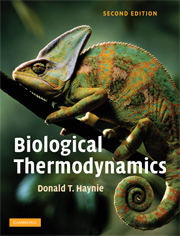Book contents
- Frontmatter
- Contents
- Preface to the second edition
- Chapter 1 Energy transformation
- Chapter 2 The First Law of Thermodynamics
- Chapter 3 The Second Law of Thermodynamics
- Chapter 4 Gibbs free energy – theory
- Chapter 5 Gibbs free energy – applications
- Chapter 6 Statistical thermodynamics
- Chapter 7 Binding equilibria
- Chapter 8 Reaction kinetics
- Chapter 9 The frontier of biological thermodynamics
- Appendices
- Glossary
- Index of names
- Subject index
- References
Chapter 4 - Gibbs free energy – theory
Published online by Cambridge University Press: 05 June 2012
- Frontmatter
- Contents
- Preface to the second edition
- Chapter 1 Energy transformation
- Chapter 2 The First Law of Thermodynamics
- Chapter 3 The Second Law of Thermodynamics
- Chapter 4 Gibbs free energy – theory
- Chapter 5 Gibbs free energy – applications
- Chapter 6 Statistical thermodynamics
- Chapter 7 Binding equilibria
- Chapter 8 Reaction kinetics
- Chapter 9 The frontier of biological thermodynamics
- Appendices
- Glossary
- Index of names
- Subject index
- References
Summary
Introduction
This chapter discusses a thermodynamic relationship that provides a basis for explaining spontaneous chemical reactivity, chemical equilibrium, and the phase behavior of chemical compounds. The relationship involves a thermodynamic state function that enables prediction of the direction of a chemical reaction at constant temperature and pressure. The constraints of fixed T and p might seem annoyingly restrictive, because they are less general than the requirements of the Second Law, but in fact the gains made on imposing the constraints will outweigh the losses. How is that? One reason is at any given time an individual organism is practically at uniform pressure and temperature (but be sure to see the Exercises at the end of the chapter). Another is that constant temperature and pressure are the very conditions under which nearly all bench-top biochemistry experiments are done. Yet another is that, although the total entropy of the universe must increase in order for a process to be spontaneous, evaluation of the total entropy change requires measurement of both the entropy change of the system and the entropy change of the surroundings. Whereas ΔSsystem can often be found without too much difficulty, albeit only indirectly, ΔSsurroundings can be hard to measure! How could one measure the entropy change of the rest of the universe? The subject of the present chapter provides a way around the difficulty.
- Type
- Chapter
- Information
- Biological Thermodynamics , pp. 85 - 133Publisher: Cambridge University PressPrint publication year: 2008
References
- 1
- Cited by



